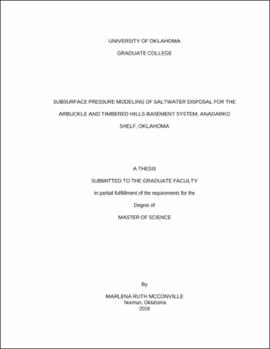| dc.description.abstract | Increased saltwater disposal (SWD) into a geologic zone, the Arbuckle Group, has been related to higher than background levels of seismicity in Oklahoma since 2009. Recent studies have shown statistical associations of saltwater disposal rates, and some hydrogeological models have suggested that pressure in the Arbuckle and basement increased after increased SWD rates. However, previous attempts to model the influence of SWD on pressures within the Arbuckle Group and Basement rock of Oklahoma lacked downhole pressure observations to use for calibration and validation. The present study created a four-dimensional (x, y, z, time) hydrogeologic model calibrated against downhole pressure data to better illustrate SWD injection effects on pressure propagation in the Arbuckle Group and its potential contribution to seismicity.
Fifteen inactive Arbuckle SWD wells located in areas of high-rate injection and seismicity, have been instrumented since August 2016 with pressure transducers to collect high-resolution pressure data every 30 seconds. A four-layer groundwater flow model was constructed using Modular Three-Dimensional Finite-Difference Groundwater Flow (MODFLOW) within the Anadarko Shelf region in northwestern Oklahoma encompassing six of the monitoring wells. The model was run under steady-state conditions and transient conditions to simulate pressure propagation from active SWD wells.
A transient MODFLOW model was calibrated against pressure data collected from the instrumented inactive SWD wells. Previously published hydraulic conductivity and specific storage must be increased by one to two orders of magnitude to match simulated to observed heads using the MODFLOW model. The best fit hydraulic conductivity and specific storage values are 1.9 m/d and 4.53E-07 m-1, respectively. Previous studies suggest a heterogenous and anisotropic Arbuckle Group, so this study assigns the Middle Sub-layer of the Arbuckle as less permeable than the Upper and Lower Sub-layers, decreasing the head residual in Grant_06, but increasing the residual in Alfalfa wells. With the Arbuckle as a homogenous and isotropic unit, a fault zone of higher vertical conductivity that emulates vertical anisotropy must be present near Alfalfa_02 and Alfalfa_03 to fit simulated heads to observed heads. Using the calibrated groundwater flow model, there was not a significant simulated pressure change in the Timbered Hills-Basement near the location of the Fairview earthquake sequence. | en_US |
